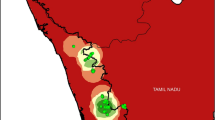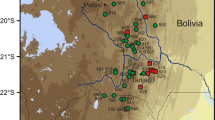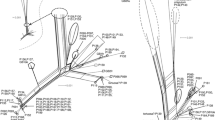Abstract
Dendrocalamus is an economically important woody bamboo genus from the Old World tropics. The traditional circumscription of the genus is not satisfactory owing to overlapping limits between Bambusa and Dendrocalamus. Limited earlier studies in the genus, using molecular techniques, have reported wide genetic variation, and there is disagreement among published infrageneric classifications in the genus. Thus, lack of sound taxonomy is hindering scientific conservation and management of the woody bamboos belonging to this genus. In the present study, amplified fragment length polymorphism markers (AFLPs), generated using five primer combinations, were used to investigate relationships among ten Dendrocalamus (D. strictus, D. hamiltonii, D. membranaceus, D. brandisii, D. sikkimensis, D. asper, D. giganteus, D. calostachyus, D. sahnii and D. somdevai) and five outgroup species (Bambusa balcooa, Dinochloa macclellandii, Melocalamus compactiflorus, Oxytenanthera abyssinica and Thyrsostachys siamensis) from subtribe Bambusinae. Neighbour-joining and maximum-parsimony analyses of AFLP dataset provided evidence for polyphyly in the current circumscription of Dendrocalamus. All Dendrocalamus taxa, except D. strictus, clustered into three monophyletic groups. The type species Dendrocalamus strictus was found to be genetically distant from the rest of the Dendrocalamus and did not cluster into any of these groups. Furthermore, Bambusa balcooa was recovered in a cluster containing D. hamiltonii and D. sikkimensis. The study did not find support for the various earlier infrageneric classifications within Dendrocalamus. The implications of the findings are discussed.



Similar content being viewed by others
References
Alam MK, Sarker RH, Hassan MA (1997) Chemotaxonomic studies in peroxidase isozyme of bamboos from Bangladesh. Bangladesh J Bot 26:99–105
Bentham G (1883) Gramineae. In: Bentham G, Hooker JD (eds) Genera plantarum III. Reeve, London, pp 1094–1215
Biswas S (1998) Contribution to the isozyme studies on Indian bamboo Dendrocalamus strictus (Roxb.) Nees with emphasis on diversity evaluation. Ann For 5:168–172
Chase MW, Hills HH (1991) Silica gel: an ideal material for field preservation of leaf samples for DNA studies. Taxon 40:215–220
Chou CH, Hwang YH (1985) A biochemical aspect of phylogenetic study of Bambusaceae in Taiwan III. The genera Arthrostylidium, Chimonobambusa and Dendrocalamus. Bot Bull Acad Sin 26:155–170
Clark LG (1997) Diversity, biogeography and evolution of Chusquea. Linn Soc Symp Ser 19:33–44
Doyle JJ, Doyle JL (1990) Isolation of plant DNA from fresh tissue. Focus 12:13–15
Felsenstein J (1985) Confidence limits on phylogenies: an approach using the bootstrap. Evol 39:783–791
Gamble JS (1896) The Bambuseae of British India. Ann R Bot Gard 7:1–133
Hodkinson TR, Renvoize SA, Chonghaile GN, Stapleton CMA, Chase MW (2000) A comparison of ITS nuclear rDNA sequence data and AFLP markers for phylogenetic studies in Phyllostachys (Bambusoideae, Poaceae). J Pl Res 113:259–269
Hsueh C, Li DZ (1988) A study on the genus Dendrocalamus Nees from China. J Bamboo Res 7:1–19
Inada T (2004) African bamboos: an appraisal with special reference to Oxytenanthera abyssinica, the savanna bamboo, Ph.D. thesis, Bangor University
Jaccard P (1908) Nouvelles recherches sur la distribution florale. Bull Soc Vaud Sci Nat 44:223–270
Koopman WJM, Zevenberger MJ, Van Den Berg RG (2001) Species relationships in Lactuca s.l. (Lactuceae, Asteraceae) inferred from AFLP fingerprints. Am J Bot 88:1881–1887
Koopman WJM, Wissemann V, Cock KD, Huylenbroeck JV, Riek JD, Sabatino GJH, Visser D, Vosman B, Ritz CM, Maes B, Werlemark G, Nybom H, Debener T, Linde M, Smulders MJM (2008) AFLP markers as a tool to reconstruct complex relationships: a case study in Rosa (Rosaceae). Am J Bot 95:353–366
Li DZ, Stapleton C (2006) Flora of China. http://www.efloras.org. Accessed 20 Dec 2007
Loh JP, Kiew R, Set O, Gan LH, Gan YY (2000) A study of genetic variation and relationships within the bamboo subtribe Bambusinae using amplified fragment length polymorphism. Ann Bot 85:607–612
Mueller UG, Wolfenbarger LL (1999) AFLP genotyping and fingerprinting. Trends Ecol Evol 14:389–393
Munro W (1868) A monograph of Bambusaceae, including descriptions of all the species. Trans Linn Soc Lond 26:1–157
Ohrnberger D (1999) The bamboos of the World: annotated nomenclature and literature of the species and the higher and lower taxa. Elsevier, Amsterdam
Pavlicek A, Hrda S, Flegr J (1999) FreeTree: freeware programme for construction of phylogenetic trees on the basis of distance data and bootstrap/jackknife analysis of tree robustness. Application in the RAPD analysis of the genus Frenkelia. Folia Biol 45:97–99
Perrie LR, Brownsey PJ (2005) Genetic variation is not concordant with morphological variation in the fern Asplenium hookerianum sensu lato (Aspleniaceae). Am J Bot 92:1559–1564
Ramanayake SMS, Meemaduma VN, Weerawardene TE (2007) Genetic diversity and relationships between nine species of bamboo in Sri Lanka, using random amplified polymorphic DNA. Pl Syst Evol 269:55–61
Rohlf FJ (2000) NTSYSpc: numerical taxonomy and multivariate analysis system, version 2.11X. Applied Biostatistics, New York
Saitou N, Nei M (1987) The neighbour-joining method: a new method for reconstructing phylogenetic trees. Mol Biol Evol 4:406–425
Stapleton CMA (1994) The bamboos of Nepal and Bhutan, Part I. Edinb J Bot 51:1–32
Sun Y, Xia N, Lin R (2005) Phylogenetic analysis of Bambusa (Poaceae: Bambusoideae) based on internal transcribed spacer sequences of nuclear ribosomal DNA. Biochem Genet 43:603–612
Swofford DL (2002) PAUP*: phylogenetic analysis using parsimony (*and other methods), version 4.0b10. Sinauer, Sunderland
Vos P, Hogers R, Bleeker M, Reijans M, Van de Lee T, Hornes M, Frijters A, Pot J, Peleman J, Kupier M, Zabeau M (1995) AFLP: a new technique for DNA finger printing. Nucleic Acids Res 23:4407–4414
Watanabe M, Ito M, Kurita S (1994) Chloroplast DNA phylogeny of Asian bamboos (Bambusoideae, Poaceae) and its systematic implication. J Pl Res 107:253–261
Yang HQ, Yang JB, Peng ZH, Gao J, Yang YM, Peng S, Li DZ (2008) A molecular phylogenetic and fruit evolution analysis of the major groups of the paleotropical woody bamboos (Gramineae: Bambusoideae) based on nuclear ITS, GBSSI and plastid trnL-F DNA sequences. Mol Phylogenet Evol 48:809–824
Zhang W, Clark LG (2000) Phylogeny and classification of the Bambusoideae (Poaceae). In: Jacobs SWL, Everett J (eds) Grasses: systematics and evolution. CSIRO, Melbourne, pp 35–42
Acknowledgments
The first author acknowledges the financial help, in the form of Commonwealth Scholarship, from the Commonwealth Scholarships Commission, UK. Sincere thanks are due to Dr. Katherine Steele, CAZS-Natural Resources, Bangor University for introducing the first author to the intricacies of the AFLP technique and generously allowing to use her laboratory facility for this investigation. Many friends and colleagues from FRI, Dehra Dun; RFRI, Jorhat; SFRI, Itanagar; ICAR Research Complex for NEH region, Basar; Central National Herbarium, BSI, Kolkata extended their generous help during the field visits of the first author, which is gratefully acknowledged. Also, the first author thanks Sri M. Lokeswara Rao, Head, Forest Research Centre (ICFRE), Hyderabad, for his encouragements to publish this material.
Author information
Authors and Affiliations
Corresponding author
Rights and permissions
About this article
Cite this article
Pattanaik, S., Hall, J.B. Molecular evidence for polyphyly in the woody bamboo genus Dendrocalamus (subtribe Bambusinae). Plant Syst Evol 291, 59–67 (2011). https://doi.org/10.1007/s00606-010-0380-4
Received:
Accepted:
Published:
Issue Date:
DOI: https://doi.org/10.1007/s00606-010-0380-4




